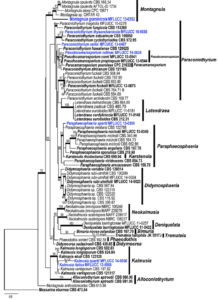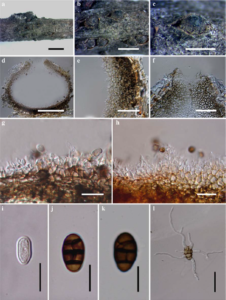Pseudocamarosporium cotinae Norphanphoun, Bulgakov & K.D. Hyde.
Index Fungorum number: IF550922, Facesoffungi number: FoF00492; Fig. 2
Etymology – Named after the generic name of host, Cotinus.
Holotype – MFLU 14–0774
Saprobic on dead herbaceous branches of Cotinus coggygria. Sexual morph Undetermined. Asexual morph Conidiomata pycnidial, 400 – 600 μm diam. 370 – 620 μm high, solitary to gregarious, black, sub-immersed, unilocular, with a papillate ostiole. Pycnidial wall 50 – 60 μm, multi–layered, with 3 – 5 outer layers of brown–walled cells of textura angularis, with inner most layer thin, hyaline. Conidiophores reduced to conidiogenous cells. Conidiogenous cells blastic, phialidic, hyaline, smooth, formed from the inner most layer of pycnidium wall. Conidia 12 – 15 × 6 – 9 μm (x̄ = 13.5 × 7.5 μm, n = 30) oblong to ellipsoidal, mostly straight, infrequently slightly curved, muriform, with 1 – 3 transverse septa, with 1 – 2 longitudinal septa, constricted at the septa, initially hyaline, brown to dark brown at maturity, narrowly rounded at both ends, smooth– walled.
Culture characters – Conidia germinating on MEA within 24 h. Colonies on PDA slow growing, reaching 1 cm diam. after 1 week at 25 °C, later producing dense mycelium, circular with rough margin, white at first, greenish-yellow after 7 days, flat or effuse on the surface, without aerial mycelium. Hyphae septate branched, hyaline, thin.
Material examined – RUSSIA, Rostov region, Shakhty city, near Grushevsky pond, shelterbelt artificial forest, on dead branches of Cotinus coggygria Scop. (Anacardiaceae), 18 March 2014, T. Bulgakov (MFLU 14 – 0774, holotype); living culture, MFLUCC 14–0624; GenBank ITS: KP744460;LSU: KP744505; SSU: KP753964.
Notes – Wijayawardene et al. (2014) introduced Pseudocamarosporium, with the type species P. propinquum, from Salix vitellina, and four other species. Pseudocamarosporium propinquum has oblong conidia. Our collection differs from the type in having oblong to ellipsoidal conidia which are narrowly rounded at both ends. The new species also has larger conidiomata than other species of Pseudocamarosporium, and also differs in sequence data (Fig. 1). Pseudocamarosporium cotinae clusters with P. corni (Wijayawardene et al. 2014) which provides good evidence that P. cotinae belongs in Pseudocamarosporium, where it forms a well-resolved clade. Hence we introduce it as a new species.

Fig. 1 Phylogram generated from Maximum likelihood analysis based on combined SSU, LSU, ß- tubulin and ITS sequence data of Didymosphaeriaceae. Maximum likelihood bootstrap support values greater than 50 % are indicated above and below the nodes, and branches with Bayesian posterior probabilities greater than 0.95 are given in bold. The ex-types (reference strains) are in bold; the new isolates are in blue. The tree is rooted with Massarina eburnea CBS 473.64.

Fig. 2 Pseudocamarosporium cotinae (holotype) a Habit in wood b Conidiomata on substrate c Single conidioma d Cross section conidioma e Peridium f Apex of conidioma g, h Conidiogenous cells with attached conidia i Immature conidia j, k Mature conidia l Germinating conidium. Scale bars: d = 200 μm, e, f = 50 μm, g, h = 20 μm, i – k = 10 μm , l = 50 μm.
